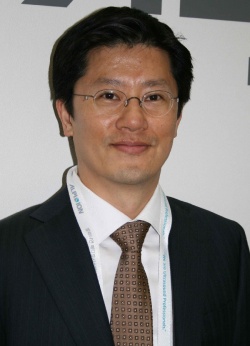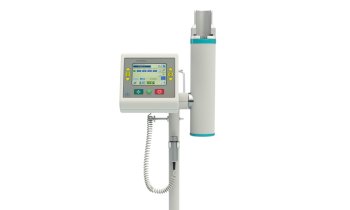Korea’s Alpinion Medical Systems
Pragmatic and happy to take a long deep breath all the way to the top
ILJIN, the shareholder of Alpinion Medical Systems, which began as a Korean die-casting and electrical business 44 years ago, is today an international high-tech company.

Whilst still to the fore in the power transmission and distribution business, with products such as transformers, cables and switchgear, the company also produces raw materials such as synthetic industrial diamonds and copper foil for use in electronic equipment and batteries. ‘If you open up a cell phone, you see a lot of foil. It’s a basic material for electronics. We also make LED. Our product portfolio is highly diversified,’ explained Jungsuk Huh, President and CEO of ILJIN Holdings. During an interview with Daniela Zimmermann (EH, which included Y C Hwan, CFO of Alpinion Medical Systems’, one of ILJIN’s 14 subsidiaries, the discussion turned to the firm’s medical equipment manufacturing
Established in 2007, Alpinion produces ultrasound imaging systems for diagnosis and therapy, as well as advanced piezoelectric and single crystal transducers. The company’s E-CUBE ultrasound series, for example, includes the E-CUBE 9, which debuted at MEDICA 2011.
This handsome equipment, which won the Red Dot design award in that same year, features superior image quality with its own advanced transducer technologies, including the world’s first 4-D single crystal transducer. Alpinion is also the only company in Korea to develop and commercialise HIFU (High Intensity Focused Ultrasound) systems, considered to be the ‘future of ultrasound technology’.
’We decided to enter the medical device industry because there will be many opportunities in healthcare in the future,’ Jungsuk Huh explained. ‘For most of our businesses you need to take a long breath, which means you have to wait. When you start from the development stage, it takes a long time until a product is commercialised and accepted by customers. Our basic materials business has the same characteristic – it takes a very long breath. With a medical device, I know that we have to put in a lot of time until it is mature as a product and accepted by doctors. ‘We have good electronics engineers. We can utilise these resources to develop an imaging device. That can be a synergy and may be our reason to enter and succeed in this business.
‘I know I need a lot of patience. Twenty years ago, we invested in a biomaterials business in Boston, Massachusetts. We are still growing the company. It began from the development stage – by a very prominent doctor from Harvard Dental School. We met when he only had the idea of developing the biomaterial concept, which is used for the musculoskeletal (MSK) area. ‘Why did we start this very hard medical device business? We first considered it in 2004. Korea is a country with few natural resources, except human ones. At that time, all the smartest students in the country were going to medical school and into engineering – especially electronics. Korea’s economy is therefore driven basically by the IT-based business, above all manufacturing. Due to that resource, the medical industry itself, or the healthcare industry generally, could develop very quickly in Korea. In the world healthcare market, which totals about $350 billion, Korea has just one percent of the market share on the manufacturing side. We think Korea can increase its market share.’
Asked whether a further natural progression would be for the firm to take a leading role in the medical industry, Jungsuk Huh responded: ‘That’s our idea. Basically ILJ IN grew into a technology-driven company. We are focused on engineering our technology, so that’s a perfect match for this business. We are very good at long-harvesting business - it took 20 years to develop the Boston business, almost 15 to become successful in copper foil and in diamonds it took a long time to develop the product. So I think in the medical device business cash-back will take maybe 15 or 20 years. However, being technology-driven we can endure for a long time. That’s a perfect match for ILJ IN, and a perfect match for the Koreans. That’s why we started Alpinion. ‘M&A by big players and continuous shift-up of technology by overall manufacturers are a trend in the ultrasound market,’ he added.
However, ILJ IN’s leaders are far from fazed by any of these factors. ‘We’re enjoying this moment; we are now challenging and knocking on the market door. There might be hard times to face in the near future – this year and next– but I think that we can enjoy that.’ Indeed, ILJ IN intends to invest more in healthcare and medical devices. It already includes the Boston enterprise and has invested in a specialist immunosuppressant pharmaceutical company in Canada. For now this is a small investment, he said though adding: ‘We believe it will progress in the future. We will participate more if the program goes well – which we expect. We have some plans, but they’re still secret. The group’s perspective is certainly forward looking. ‘The five-year goal is that we will not be number one in Korea or Asia. If we acquire a lot of companies we can get bigger and have higher revenues easily, but getting the sales or growing bigger is not the point. We want to be the most valuable, most respected company in this business. That is our principle and philosophy. Acquiring or investing more is just one path we’ll choose. This principle or philosophy cannot change.’
At this point, the discussion turned to the design and construction of Inchon International Airport, a national gateway for foreign visitors to Korea. ‘The ceiling construction of the whole airport buildings is ILJ IN’s engineering’, Jungsuk Huh said proudly. ‘So is the airport power cable.’ ‘We started our business in electricity – power. The core attribute of the power business is reliability. Philips and GE – why have they been in the business for 100 years? They are reliable. ILJ IN also has that reliability.’ So, in a way, ILJ IN welcomes every visitor to Korea? ‘Yes,’ the CEO confirmed with a smile.
30.04.2012











